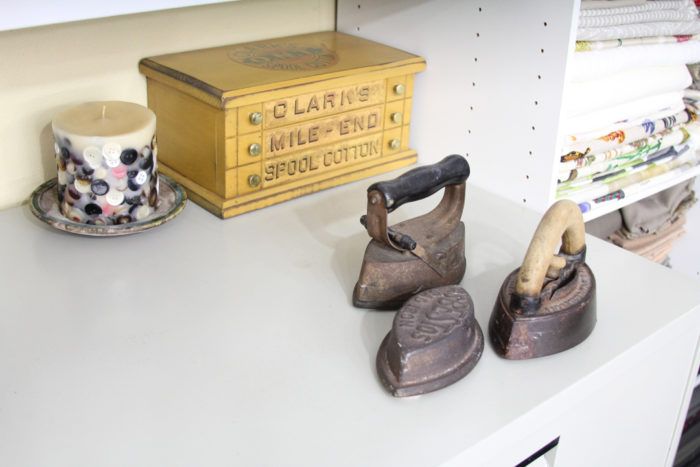
Three vintage irons and a Clark's Mile-End cotton thread display case. Of the irons, Louise found the one with the black handle at an antiques shop, but the other two belonged to her mother.
In Threads #173, we visited the sewing studio of contributing editor Louise Cutting. Louise’s sewing space is on the second floor of her Winter Park, Florida, home. It’s packed with collections and fun items that reflect her interest in sewing and career as an instuctor, pattern designer, and artist.
There was so much to see in Louise’s studio that we decided to offer this additional online look at more of her sewing room and collected items, with insight on each image from Louise. Enjoy, and happy sewing!
 Take a look at more sewing studios and spaces:
Take a look at more sewing studios and spaces:
• Another Look at Kenneth D. King’s Sewing Space
• An Inside Look at Mary Ray’s Sewing Studio
• Ruth Ciemnoczolowski’s Sewing Room
• Helen Haughey’s Favorite Tools and Storage Solutions
More from Louise:
Louise found these whimsical hands at a display house. They are “glove” hands and also traditionally used to display jewelry.

Usually they would stand upright on a store counter, but Louise’s carpenter drilled a clamp into the side of the cabinet so that the each hand could hook on. The hand was in an odd salmon color, so Louise spray-painted them white.

Three vintage irons and a Clark’s Mile-End cotton thread display case. Of the irons, Louise found the one with the black handle at an antique shop, but the other two belonged to her mother.
Louise is a whiz at collars, of course (see her story, “Precision Collar Band,” in Threads #173). Louise found these miniature “collar candleholders at anthropologie about three years ago.

The details are rendered correctly, she says, around the back of the “collars” you have what you would normally see inside a man’s shirt collar.
Unfortunately, Anthropologie no longer carries them, but they are fun, aren’t they?

Another great sewing-related candle, this one packed with buttons. Louise found it at an antique store.
Louise enjoys lovely vintage buttons, and has a collection on display in her studio, including Bakelite buttons, and old-time, high-shoe buttons. The framed buttons have old newsprint as a background, and the displays were found in an antiques mall. Louise is sure someone did them as a craft class.

The wooden box on the shelf was Louise’s grandmother’s. It is a spool box with a pincushion on top, and the little holes are where the thread “spools” out. The bird is an antique and well-loved pincushion.
See more images on the next page.
Some of these miniature sewing machines are teapots and others are music boxes. Louise says her late husband always tried to find unusual items related to sewing for her.

The white one is a teapot, the black one behind it is a music box, as is the one with tiny mice that turn around with fabric and lace as the music plays.

In all, Louise thinks she has about 30 miniature sewing machine teapots or music boxes around her sewing studio and home.

Louise is finishing two versions of her new jacket pattern, “The Director’s Cut.” With the pattern ready, samples sewn, pattern cover illustrations drawn, and instructions written (whew!) the pattern is ready and will be available in June 2014.
Tiny dolls line up atop the bookcases where Louise stores fabric, carefully folded and sorted by color.

Most are Ginny dolls, a figure that predated Barbie by about 10 years. Ginny is 6 1/2 inches tall, and Louise learned to sew by making clothes for her. Louise says the Ginny doll was so popular, that the “Big 4” pattern companies had patterns for her.
Louise points out that if you examine the doll’s purchased garments, they had hand-sewn snaps and buttons and 1-inch zippers! There are also few Madame Alexander dolls (you weren’t allowed to play with them) and a Muffy doll (a Ginny knock-off) and Jill, Ginny’s big sister. Jill is a much more realistic version of a teenager than Barbie, Louise says. All of her dolls are collector’s items.
See more images on next page.
Another view of the dolls Louise has collected.

Most of the dolls were Louise’s from childhood, but she ran across additional ones over the years. Now antiques shops and collectors know what they have and Ginny dolls are priced accordingly, as well as their garments, especially if the doll and/or the garments are still in boxes.
Above some of Louise’s cabinets, tiny shopping bags keep the corner colorful.

All are from high-end shops around the world. Louise took several classes in college dealing with packaging. “Many of the bags are so eye-catching, I couldn’t throw them away, or so beautifully constructed that they are like little works of art,” Louise says.

“Like everyone else, I get tons of catalogs,” Louise says. “You never know when the sewing theme will crop up.” These oversized wooden scissors were from the Ballard Designs catalog.
Jumbo pencils hang over a framed fashion illustration Louise created for the packet cover of one of her Cutting Line patterns. “No matter what catalog comes to the door, I always look through it,” Louise says. “The pencils were in a Pottery Barn Kids catalog on clearance! You could have them monogrammed with your child’s name on them, and they came in the three primary colors. My three ‘children’ were Cutting…Line…Designs,” Louise says. “I’m sure someone at Pottery Barn was scratching their heads at that one!”

All of Louise’s hand-drawn pattern illustrations are framed and hung on the doors of the cabinets in the sewing room. Extras are along the hall wall outside of the room, and now Louise is running out of space!
Do you have a sewing room or dedicated area? What are some of your favorite design or decor pieces found in your sewing space? What would your dream sewing room look like?


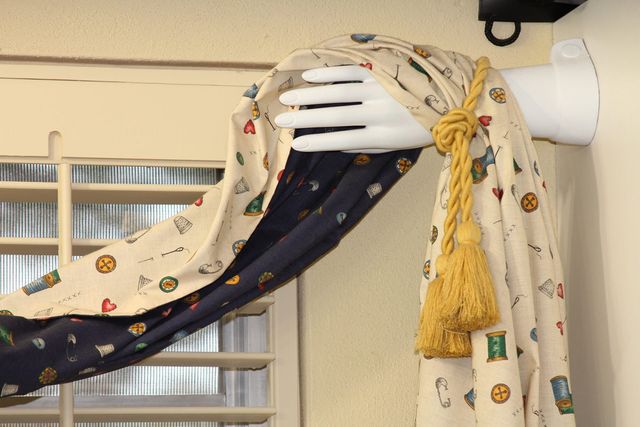



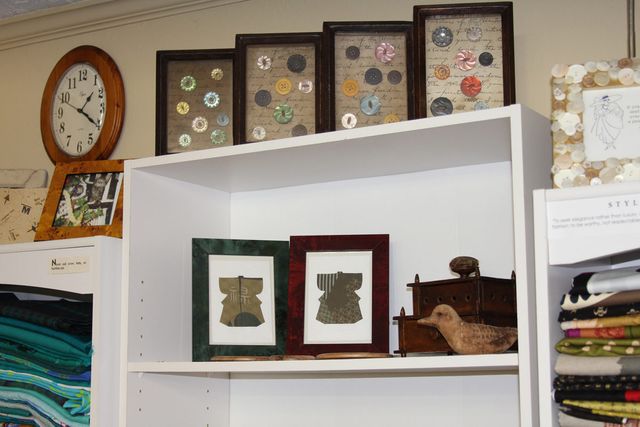



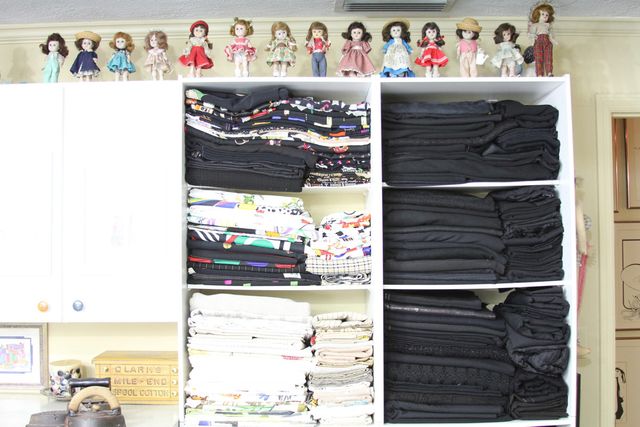
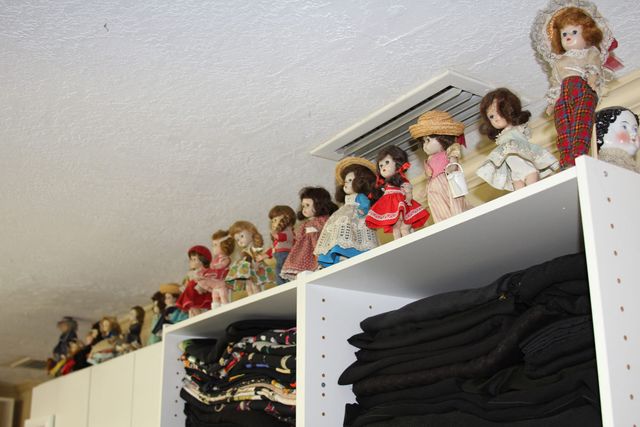


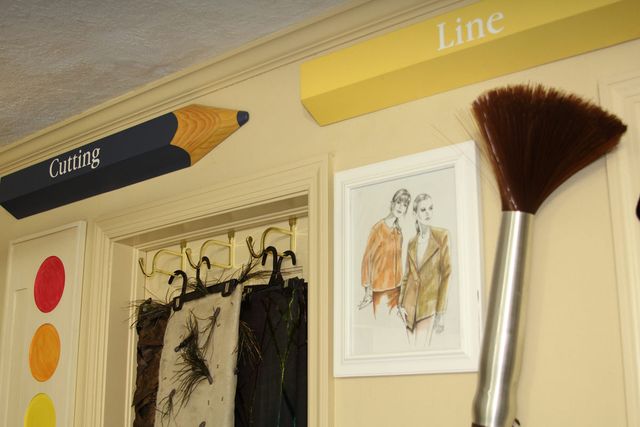

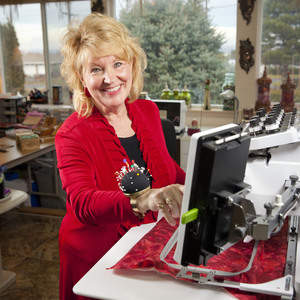
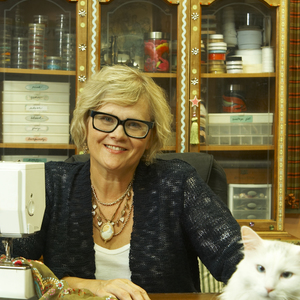




























Only 2 pictures showed the actual room, all the other pictures were close up shots of items in the room. The article mainly talked about the items used to decorate room and nothing seem to discuss about the actual function of the room. For once I am disappointed in an article in Threads, unfortunately.
Nice pictures..Really very inspiring..
I feel most SPECIAL; I have the identical little Plastic "Treadle" Sewing Machine that Louise has. I can date mine with total accuracy too. At Easter in 1948 my one Grandmother gave us three children each a Day Old Chicken as our "Easter Egg". At that time in England Sugar and most other foodstuffs were strictly rationed, including eggs, so a chicken that would grow to be an Egg producing Hen was not only sensible, but also fun; plus my mother already had 4 or 5 hens in the back garden that were 'off ration'; not enough for her to loose her Egg Ration, or too many to manage to feed with scraps and foraging amongst the garden plants. Anyway the Chicken Hatchery was a long bus ride from our home and my Gran did not feel able to take me; a mere 3 year old, along with mt older brothers. So as a reward for not going she managed to find this little toy in a shop in the small town they went to. I have it up on a bookshelf in my sitting room; it has always been around, and it has suffered no damage despite moving house too many times. Mine is slightly different in colour; The Hand Crank and folding side/top are Red, the Treadle Foot Plate and machine Bed are Yellow, and the Machine, Top, side irons, and drawers are Blue. The rear back flap lifts up so the head can be lowered and the side extension/top folded across to make it into a "Concealed Model". Even more amazing; the foot pedal is on minute bearings so it can be moved, although there is no Pitman, and when you turn the Hand Crank the metal 'Needle' goes up and down! I am so happy someone else has one "JUST THE SAME"; I must have been a most careful child for it to have lasted so long since I did play with it; it graced my childhood Doll House for many years. Liz
Louise: I love your sewing studio pictures. We have very much the same taste and ideas. I have a large wooden scissors like that, a lot of the tea pots you have and also the little sewing machines. I love the vintage look of sewing paraphernalia you use in decorations. I do want to go all white in my sewing area because things seem to pop when you use a white. Thank you for sharing with all of us other sewing sisters.